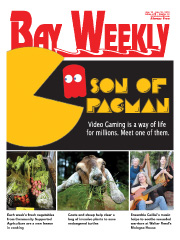Unclogging the Bog
Goats, sheep clear the way for endangered turtles

by Margaret Tearman
Drive north past Baltimore into Carroll County on Maryland Route 30, and you may rub your eyes and wonder if they’re playing tricks on you. No, your imagination is not running wild. Those are goats and sheep grazing alongside the highway.
But they are not just any goats and sheep. They are state contractors, hired to mow the lawn — and save the turtles.

The Turtles
Several years back, the Maryland State Highway Administration purchased land along the old Hanover Pike, now known as Route 30, north of Reisterstown. The growing population in neighboring counties and commuters coming from southern Pennsylvania were clogging the route with traffic, especially where it crossed through the town of Hampstead.
To ease the congestion, Maryland planned to construct a 4.5-mile-long bypass around Hampstead. But early in the planning, state biologists discovered that tiny native bog turtles made their homes on the land to be paved.
Bog turtles are listed as threatened under the Federal Endangered Species Act. The turtles are about four and half inches long, have dark bodies with bright yellow, orange or red blotches on their heads and live up to 30 years in calcium-rich wetlands, wet meadows and bogs.
Either the byway or the turtles had to go.
“We shifted the location of the highway to avoid the turtle habitat,” says Maryland Highway Administration spokesman Charlie Gischlar. “We were able to preserve the bog, which is just beautiful.”
Goats and Sheep
The turtles were saved. But the bog itself needed some TLC to keep healthy.
“Invasive plant species, like the multiflora rose, were beginning to take over and threatened the bog,” Gischlar explains. “We couldn’t go in there with heavy machines to mow down or dig out the invasives. We would kill turtles, and the ruts left by the tires could alter the hydrology of the bog.”
Pesticides were not an option.
So the biologists turned to conservation grazing, which employs goats and sheep to mow down the vegetation.
“They weigh a lot less than a man on a mowing machine. And they eat everything but the turtles,” says Gischlar. “Those invasive plants are some of their favorite foods.”
Last year the goats and sheep made their first pass on the bypass land.
“It was wildly successful,” Gischlar says.
The entire bog area is fenced, both to keep goats and sheep on task and to keep the turtles from wandering out of the bog and onto the road.
The emission-free mowing is a two-year, $10,000 pilot program and part of Gov. Martin O’Malley’s Smart, Green and Growing initiative. The cost of hiring the animals — roughly $5,000 a year — includes delivery of the sheep and goats to and from the project, supplemental feed and routine vet care. Conventional mowing of the approximately eight acres, including manpower, equipment, time — and repair to the bog — would cost significantly more.
The goats and sheep began munching in May and will continue until early September, when the growing season ends and the turtles go into hibernation.
A Green Way
The Hampstead bypass is located in a naturally rich environmental area that is home to more than the endangered bog turtles. Several native — and endangered — plant species grow there. Or try to.
“We’re trying to do things to protect rare and threatened species in the bypass area,” Gischlar told Bay Weekly. “We have put aside a hair over 250 acres to preserve and protect them from any future growth.”
The bypass was completed about a year ago.

Hampstead Elementary School children tour the American chestnut fields along the Hampstead Bypass preservation area.
|

“We like to think of it as a green highway,” Gischlar says. “Old Route 30, now Business Route 30, was choked by traffic, idling cars spewing emissions. Now much of that traffic has been diverted to the new bypass, reducing a lot of that idling. And we figured while we’re here, we might as well work to preserve land and the species whose survival are dependent on it.”
The Hampstead bypass preservation area includes nearly three acres where the State Highway Administration, in partnership with the Maryland Chapter of the American Chestnut Foundation, is working to re-establish the American chestnut tree. The once prolific native tree was nearly wiped out in the 1950s by a chestnut blight.
In another section of the bypass, a field of white turtlehead plants is being cultivated. The native species are the main habitat on which the official state insect, the Baltimore checkerspot butterfly, depends for survival. Already, the checkerspot’s numbers are diminishing due to loss of natural habitat. Biologists from the State Highway Administration hope the cultivated field will help support the butterfly’s population.
The project has become a living classroom for Carroll County elementary school students. A fourth grade class from Sandymount Elementary School and the fifth grade classes from Hampstead Elementary held a contest to name each of the goats and sheep, now known as the Bypass Babies. This week, students will take a field trip to the preserved bog to learn from State Highway Administration and Department of Natural Resource biologists how the bog turtle survives and how to help conserve the threatened animal.
Gischlar hopes this bypass project will teach a new generation how roads and nature can coexist — and that future highways will play a role in the greening of Maryland.
“The kids are getting a good education on land use and how to protect the environment,” Gischlar says. “As an added bonus, they get to see their named goats and sheep at work.”
|
![]()




